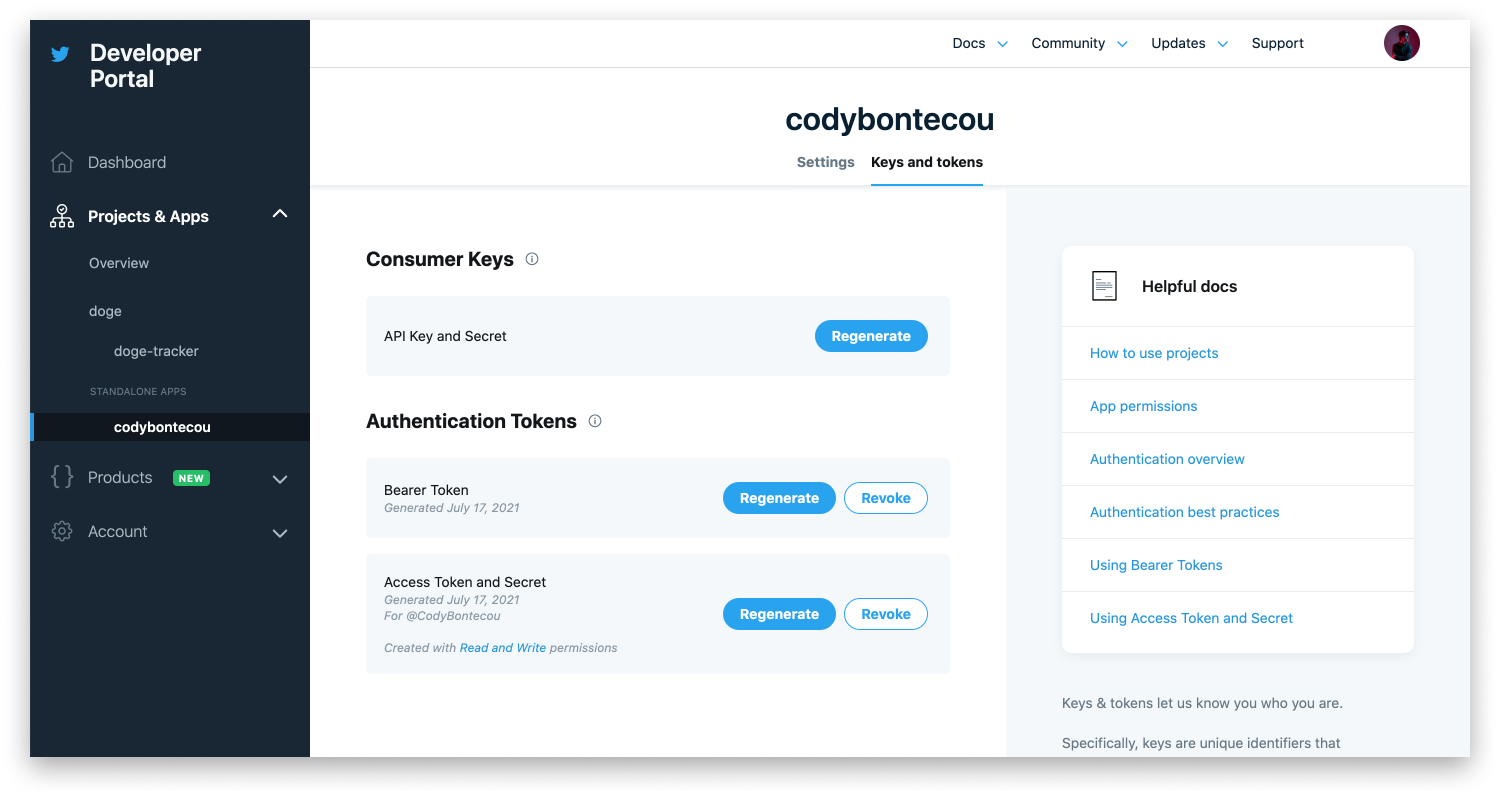https://github.com/codybontecou/day-1-tweet-with-nodejs
Day 1 of my #100DaysOfCode - Creating a Twitter tweet with NodeJS
https://github.com/codybontecou/day-1-tweet-with-nodejs
Last synced: 9 months ago
JSON representation
Day 1 of my #100DaysOfCode - Creating a Twitter tweet with NodeJS
- Host: GitHub
- URL: https://github.com/codybontecou/day-1-tweet-with-nodejs
- Owner: CodyBontecou
- Created: 2021-07-17T18:55:08.000Z (over 4 years ago)
- Default Branch: main
- Last Pushed: 2021-07-17T19:06:31.000Z (over 4 years ago)
- Last Synced: 2024-12-29T10:33:49.973Z (11 months ago)
- Language: JavaScript
- Size: 2.93 KB
- Stars: 0
- Watchers: 2
- Forks: 0
- Open Issues: 0
-
Metadata Files:
- Readme: README.md
Awesome Lists containing this project
README
_Originally posted [here](https://codybontecou.com/programmatically-tweeting-with-nodejs). This repo is here to help users who follow along_

# Creating a tweet with NodeJS
> This post is for **day 1** of my [#100DaysOfCode](https://twitter.com/hashtag/100DaysOfCode?src=hashtag_click). In this post I'll be discussing how to programmatically tweet to Twitter using NodeJS.
## Getting Authenticated
[Get a Twitter Developer Account](https://developer.twitter.com/en/docs/twitter-api/getting-started/getting-access-to-the-twitter-api)
You'll need to follow the instructions of the link above to create a develop account. This gives you access to creating a [project](https://developer.twitter.com/en/docs/projects/overview) and an [app](https://developer.twitter.com/en/docs/apps/overview).
You'll eventually find yourself within the Twitter Developer Dashboard where you can generate authentication tokens that will be essential to making requests.

## Laying the Foundations of Your App
_Make sure you have [NodeJS](https://nodejs.org/en/) installed_
_I prefer [yarn](https://yarnpkg.com/), but you can use npm instead if you prefer_
1. Scaffold your project: `yarn init -y`
2. Download [twitter-lite](https://github.com/draftbit/twitter-lite) to interact with Twitter's API: `yarn add twitter-lite`
3. Download [dotenv](https://github.com/motdotla/dotenv#readme) to safely manage .env variables and your auth tokens: `yarn add dotenv`
Your `package.json` file should now look like this:
```json
{
"name": "programmatic-tweeting-with-nodejs",
"version": "1.0.0",
"main": "index.js",
"license": "MIT",
"dependencies": {
"dot-env": "^0.0.1",
"twitter-lite": "^1.1.0"
}
}
```
4. Create a .env file in your project root folder and add your tokens provided by Twitter's API
The `.env` file should look like this:
```js
consumer_key = ''
consumer_secret = ''
access_token_key = ''
access_token_secret = ''
```
Just make sure you replace the `<>` text with the tokens Twitter provided you.
**Make sure you do not commit your .env file to Github or any other version control systems.** These tokens are very important, and should not be shared with anyone!
## Making the Post
1. Create an index.js file in your project root
2. Import the packages you installed earlier
```js
const twitter = require('twitter-lite')
require('dotenv').config()
```
3. Create a client to talk to Twitter with your config
```js
const client = new twitter(config)
```
4. Code the request
```js
client
.post('statuses/update', { status: 'Hello World' })
.then(result => {
console.log('You successfully tweeted this : "' + result.text + '"')
})
.catch(console.error)
```
Step #4 is creating a POST request to [Twitter's endpoint](https://developer.twitter.com/en/docs/twitter-api/v1/tweets/post-and-engage/api-reference/post-statuses-update) `statuses/update` with the parameter `status = 'Hello World'`.
5. Make the request
Now type `node index.js` into your terminal and press enter. This will generate a Tweet with the text "Hello World".
---
I hope this article was helpful, let me know if you have any questions, comments, or suggestions on Twitter [@codybontecou](https://twitter.com/CodyBontecou)